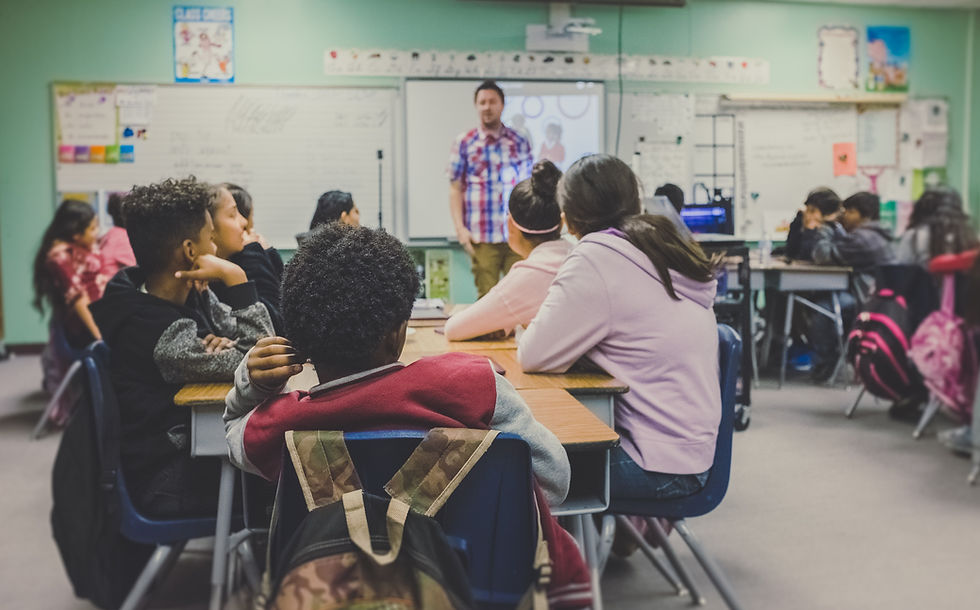In-Person School is Here to Stay
- Jennifer Smith

- Sep 16, 2021
- 4 min read

Photo Credit: NeONBRAND on Unsplash
What have we learned from our year of chaos? We have certainly learned that all students cannot learn effectively from the screen on a daily basis. Despite the many technological tools and games teachers used to create lessons and engage students, connecting from a screen leaves much to be desired.
What is missing from virtual school?
1. Human Connection
Our biggest lesson from the pandemic is how much we all need human connection. Keeping all interactions via a Zoom session is forced, and well, virtual reality not physical reality. We quickly learned spontaneous conversations cannot occur as if you were in person. Conversation is one-way rather than circular when you are in a group. Through Zoom, building relationships and connections with others proved to be very challenging for educators. During in-person classes, we often have side jokes and laughs. On screen, we miss those experiences that build community.
2. Screen tires/exhausts us
Everyone learned over the past 18 months that working constantly on the screen has its disadvantages. Many articles were written detailing the science of how Zoom fatigues us more than real life. We are not receiving the same cues nor are we having the same interactions that we would have in- person. The intense focus wears on us. When I taught virtually, our schedule required us to be on screen with students for an entire school day. My classes could run 50 minutes, and I tried to connect with all of my students during the classes. On those days, I was completely exhausted and needed naps after school regularly.
I remember the day when my school went hybrid, and we returned to in-person learning for 3 days a week. I prepared myself mentally expecting I would be exhausted after being back in school with people in my face all day again. Quite the opposite was true. When I came home after my first day back, I was more energized than I had been in over 8 months. After chatting with many other teachers and students alike, this experience is not unique to me. As humans, we are meant to interact and connect. The long-term impacts of our dramatic increase in screen use remain to be determined, but we have all learned we cannot interact this way constantly in the future.
3. Collaboration looks and feels different
Teachers find it difficult to get students engaged in conversation and collaboration in the same manner as a physical classroom. When students collaborate in my classroom, they are loud. They engage in conversation, arguments, and negotiations. They get side-tracked and have conversations unrelated to their project. They laugh; they tell jokes. All of these interactions build relationships and community. And all of these interactions are for the most part missing virtually.
Students share responsibilities and actions. They hold each other accountable in person. Virtually, however, collaboration looks more like parallel play. Each student does their part of the project rather than getting their hands messy together in all aspects.
4. Parents cannot be responsible for their kids all day long
Over and over again, media outlets reported on parents pressing for schools to reopen. Parents became weary of managing their children’s schooling all day in addition to their own career responsibilities. Let’s face it, if you have 3 kids that need to connect to the internet at different times for their classes, and you are trying to complete a huge report from work, you are not going to accomplish your goals. Younger children had challenges connecting and managing the technology on their own while older children did not want to be held accountable and oftentimes did not show up for classes. If children are physically present in a school environment, these issues do not arise, and the management is placed upon the educators rather than the parents.
5. Spontaneous Social Interaction
Recess and social time is missing when we are in virtual school. During these moments, students learn important social skills and cues as they play. Collaboration and conflict resolution skills are developed during kickball games, tag, and other recess games. In addition, these interactive moments build relationships and friendships outside of the classroom.
However, many schools have decided to continue a virtual school program for students. Even large public districts are building a virtual option for families that want the flexibility this offers. Families who prefer homeschooling may have the opportunity to select certain virtual classes for their children that parents are not capable of instructing. Consider advanced chemistry or literature classes. If teachers were able to instruct these during the pandemic, why could they not be offered post-pandemic?
Children with disabilities or illnesses may have the ability to connect in online school in a way that was not possible pre-pandemic, and they will have the opportunity to collaborate virtually instead of simply independent learning. As well, virtual school presents opportunities for parents who may want to travel the world for a year yet keep their children enrolled in institutional learning.
Both types of schooling offer learning experiences. With the increase in use of AI, the opportunities to build more interactive programs virtually are going to increase. Demands of choice from parents will force school districts to modify their requirements and standards to suit both types of learning. In the near future, families will have many choices for their children’s education.
In person school is here to stay, but virtual will never die.





Comments